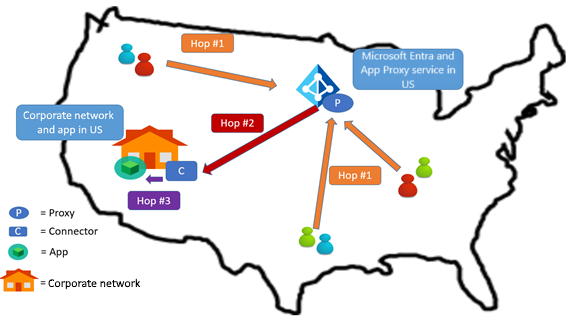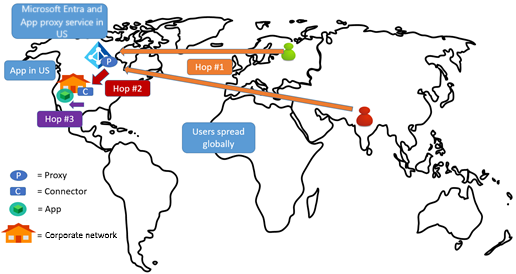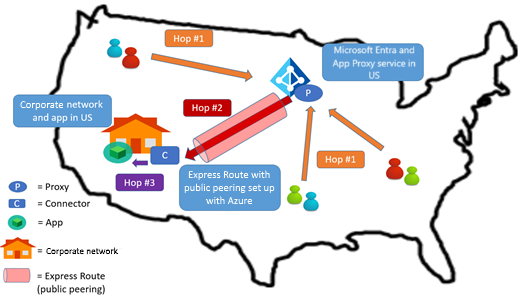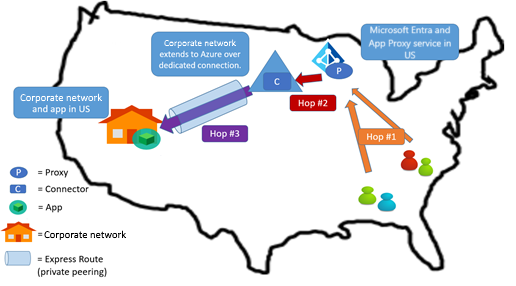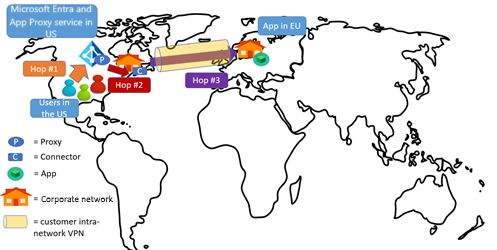Optimize traffic flow with Microsoft Entra application proxy
Learn how to optimize traffic flow and network topology considerations when using Microsoft Entra application proxy.
Traffic flow
When an application is published through Microsoft Entra application proxy, traffic from the users to the applications flows through three connections:
- The user connects to the Microsoft Entra application proxy service public endpoint on Azure
- The private network connector connects to the application proxy service (outbound)
- The private network connector connects to the target application
Optimize connector groups to use closest application proxy cloud service
When you sign up for a Microsoft Entra tenant, the region of your tenant is set with the region you choose. The default application proxy cloud service instances use the same, or closest, region as your Microsoft Entra tenant.
For example, if your Microsoft Entra tenant's region is the United Kingdom, all your private network connectors at default is assigned to use service instances in European data centers. When your users access published applications, their traffic goes through the application proxy cloud service instances in this location.
If you have connectors installed in regions different from your default region, it's beneficial to change which region your connector group is optimized for to improve performance accessing these applications. Once a region is specified for a connector group, it connects to application proxy cloud services in the designated region.
In order to optimize the traffic flow and reduce latency to a connector group, assign the connector group to the closest region. To assign a region:
Important
Connectors must be using at least version 1.5.1975.0 to use this capability.
Sign in to the Microsoft Entra admin center as at least an Application Administrator.
Select your username in the upper-right corner. Verify you're signed in to a directory that uses application proxy. If you need to change directories, select Switch directory and choose a directory that uses application proxy.
Browse to Identity > Applications > Enterprise applications > Application proxy.
Select New Connector Group and provide a Name for the connector group.
Under Advanced Settings, select the drop-down under Optimize for a specific region and select the region closest to the connectors and then select Save.
Select the connectors to assign to the connector group.
You can only move connectors to your connector group if it is in a connector group using the default region. Start with a connector in the default connector group. Then move it to the appropriate connector group.
You can only change the region of a connector group if there are no connectors assigned to it or apps assigned to it.
Assign the connector group to your applications. Traffic goes to the application proxy cloud service in the region of the optimized connector group.
Considerations for reducing latency
All proxy solutions introduce latency into your network connection. No matter which proxy or VPN solution you choose as your remote access solution, it always includes a set of servers enabling the connection to inside your corporate network.
Organizations typically include server endpoints in their perimeter network. With Microsoft Entra application proxy, however, traffic flows through the proxy service in the cloud while the connectors reside on your corporate network. No perimeter network is required.
The next sections contain more suggestions to help you reduce latency even further.
Connector placement
Application proxy chooses the location of instances for you, based on your tenant location. However, you get to decide where to install the connector, giving you the power to define the latency characteristics of your network traffic.
When setting up the application proxy service, ask the following questions:
- Where is the app located?
- Where are most users who access the app located?
- Where is the application proxy instance located?
- Do you already have a dedicated network connection to Microsoft data centers set up, like Azure ExpressRoute or a similar VPN?
The connector must communicate with both Microsoft Entra ID and your applications. Steps 2 and 3 represent the communication in the traffic flow diagram. The placement of the connector affects the latency of those two connections. When evaluating the placement of the connector, keep in mind these points.
- Confirm "line of site" between the connector and the data center for Kerberos Constrained Delegation (KCD). Additionally, the connector server needs to be domain joined.
- Install the connector as close to the application as possible.
General approach to minimize latency
Minimize the latency of end-to-end traffic by optimizing each network connection.
- Reduce the distance between the two ends of the hop.
- Choose the right network to traverse. For example, traversing a private network rather than the public internet could be faster, due to dedicated links.
Consider using a dedicated VPN or ExpressRoute link between Microsoft and your corporate network.
Focus your optimization strategy
There's little that you can do to control the connection between your users and the application proxy service. Users access your apps from a home network, a coffee shop, or a different region. Instead, you can optimize the connections from the application proxy service to the private network connectors to the apps. Consider incorporating the following patterns in your environment.
Pattern 1: Put the connector close to the application
Place the connector close to the target application in the customer network. This configuration minimizes step 3 in the topography diagram, because the connector and application are close.
If your connector needs a line of sight to the domain controller, then this pattern is advantageous. Most of our customers use this pattern, because it works well for most scenarios. This pattern can also be combined with pattern 2 to optimize traffic between the service and the connector.
Pattern 2: Take advantage of ExpressRoute with Microsoft peering
If you have ExpressRoute set up with Microsoft peering, you can use the faster ExpressRoute connection for traffic between application proxy and the connector. The connector is still on your network, close to the app.
Pattern 3: Take advantage of ExpressRoute with private peering
If you have a dedicated VPN or ExpressRoute set up with private peering between Azure and your corporate network, you have another option. In this configuration, the virtual network in Azure is typically considered as an extension of the corporate network. So you can install the connector in the Azure datacenter, and still satisfy the low latency requirements of the connector-to-app connection.
Latency isn't compromised because traffic is flowing over a dedicated connection. You also get improved application proxy service-to-connector latency because the connector is installed in an Azure datacenter close to your Microsoft Entra tenant location.
Other approaches
Although the focus of this article is connector placement, you can also change the placement of the application to get better latency characteristics.
Increasingly, organizations are moving their networks into hosted environments. The move enables them to place their apps in a hosted environment that is also part of their corporate network, and still be within the domain. In this case, the patterns discussed in the preceding sections can be applied to the new application location. If you're considering this option, see Microsoft Entra Domain Services.
Additionally, consider organizing your connectors using connector groups to target apps that are in different locations and networks.
Diagrams for common use cases
In this section, we walk through a few common scenarios. Assume that the Microsoft Entra tenant (and therefore proxy service endpoint) is located in the United States (US). The considerations discussed in these use cases also apply to other regions around the globe.
For these scenarios, we call each connection a "hop" and number them for easier discussion:
- Hop 1: User to the application proxy service
- Hop 2: application proxy service to the private network connector
- Hop 3: private network connector to the target application
Use case 1
Scenario: The app is in an organization's network in the US, with users in the same region. No ExpressRoute or VPN exists between the Azure datacenter and the corporate network.
Recommendation: Follow pattern 1, explained in the previous section. For improved latency, consider using ExpressRoute, if needed.
Optimize hop 3 by placing the connector near the app. The connector typically is installed with line of sight to the app and to the datacenter to perform KCD operations.
Use case 2
Scenario: The app is in an organization's network in the US, with users spread out globally. No ExpressRoute or VPN exists between the Azure datacenter and the corporate network.
Recommendation: Follow pattern 1, explained in the previous section.
Again, the common pattern is to optimize hop 3, where you place the connector near the app. Hop 3 isn't typically expensive, if it's all within the same region. However, hop 1 can be more expensive depending on where the user is, because users across the world must access the application proxy instance in the US. It's worth noting that any proxy solution has similar characteristics regarding users being spread out globally.
Use case 3
Scenario: The app is in an organization's network in the US. ExpressRoute with Microsoft peering exists between Azure and the corporate network.
Recommendation: Follow patterns 1 and 2, explained in the previous section.
First, place the connector as close as possible to the app. Then, the system automatically uses ExpressRoute for hop 2.
If the ExpressRoute link is using Microsoft peering, the traffic between the proxy and the connector flows over that link. Hop 2 uses optimal latency.
Use case 4
Scenario: The app is in an organization's network in the US. ExpressRoute with private peering exists between Azure and the corporate network.
Recommendation: Follow pattern 3, explained in the previous section.
Place the connector in the Azure datacenter that is connected to the corporate network through ExpressRoute private peering.
The connector can be placed in the Azure datacenter. Since the connector still has a line of sight to the application and the datacenter through the private network, hop 3 remains optimized. In addition, hop 2 is optimized further.
Use case 5
Scenario: The app is in an organization's network in Europe, default tenant region is US, with most users in the Europe.
Recommendation: Place the connector near the app. Update the connector group to use Europe application proxy service instances. For steps see, Optimize connector groups to use closest application proxy cloud service.
Because Europe users are accessing an application proxy instance that happens to be in the same region, hop 1 isn't expensive. Hop 3 is optimized. Consider using ExpressRoute to optimize hop 2.
Use case 6
Scenario: The app is in an organization's network in Europe, default tenant region is US, with most users in the US.
Recommendation: Place the connector near the app. Update the connector group to use Europe application proxy service instances. For steps see, Optimize connector groups to use closest application proxy cloud service. Hop 1 can be more expensive since all US users must access the application proxy instance in Europe.
You can also consider using one other variant in this situation. If most users in the organization are in the US, then chances are that your network extends to the US as well. Place the connector in the US, continue to use the default US region for your connector groups, and use the dedicated internal corporate network line to the application in Europe. This way hops 2 and 3 are optimized.



